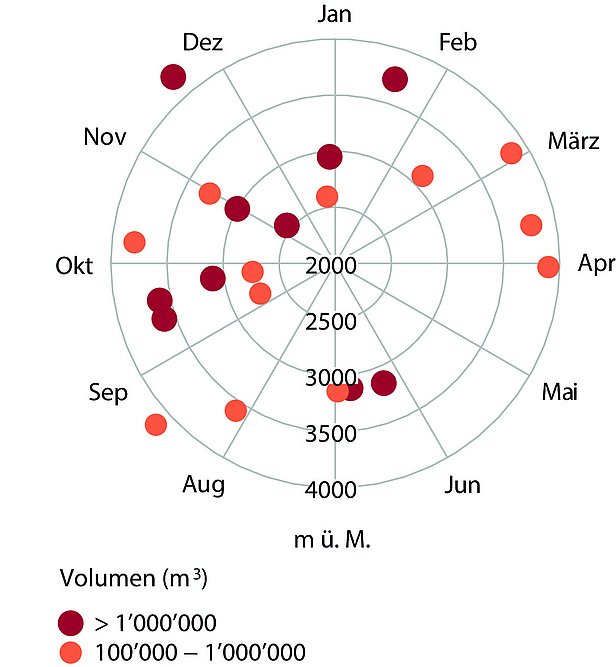In summer 2015 an exceptionally large number of rock slope failures was reported in the Swiss Alps, with a concentration in permafrost regions above 2500 m asl. Most of these failures occurred near the rock surface at depths influenced by seasonal temperature variations in the active layer.
Air temperatures were well above average (2.5 °C higher than the 1981–2010 mean) and the 0 °C isotherm was above 4000 m asl for around 6 weeks. In contrast to the particularly hot and dry summer 2003 during which widespread rock fall activity was also registered, thunderstorms and precipitation occurred at high elevations during the recent heat wave. In addition to permafrost ice, water was often visible in the detachment scars. It is probable that the combination of high air temperatures warming the rock and ice in cracks and sporadic influxes of water into rock discontinuities led to failure through temperature-related strength loss and hydrostatic pressure. Seismic activity can be ruled out as a triggering factor, as none of the events were preceded by an earthquake.
Peak of activity at the beginning of August ¶
The main reported rock fall activity started at the end of July 2015, after air temperatures had been exceptionally high for a month. On July 28th, a shallow rock slope failure with a large surface area occurred in the West flank of Piz Cambrena (Grisons) – releasing 5000 m3 of rock, which corresponds to the volume of about five houses. A series of events followed in various regions of the Swiss Alps, with a peak of activity during the first fortnight of August. The largest incident registered occurred on September 2nd at 3400 m asl in the western flank of the Grande Dent de Veisivi (Valais), with an estimated volume of 80 000 m3. The events took place at all hours of the day or night and in all aspects, except South. Rockfalls of several cubic metres were observed on a daily basis. Their dimensions varied from a few hundred to several tens of thousands of cubic metres. There were no large, deep-seated events with volumes of 100 000 m3 and more.
Rock slope failures were reported to SLF by mountain guides and mountaineers, hut wardens, helicopter pilots and regional hazard managers. The observations, which often included photographs and films were reported online via www.slf.ch or www.gipfelbuch.ch, by email or SMS. The data are registered in the SLF rockfall database, which contains several hundred events from 1714 onwards.
Large rock slope failures can occur in winter ¶
Analysis of this data shows that whereas in high and cold regions, small and medium events tend to occur mainly in the summer months, the large ones can occur at any time of year (Figure 1). Recent examples of large events in winter include the Bergsturz at Pizzo Cengalo (Grisons) in December 2011 with a volume of around 1.5 million m3 and the collapse of a rock pillar with a volume of 150'000 m3 at Piz Kesch (Grisons) in February 2014. Although these failures were mainly controlled by the structure of the rock mass and its discontinuities, permafrost related processes probably had an influence too. It is possible that other such large events may occur in winter, as large rock masses have a delayed reaction to temperature changes.
SLF collaborates closely with the Swiss Permafrost Monitoring Network PERMOS, which systematically collects permafrost field data such as ground temperature, active layer thickness, ice content and slope deformation. 9 of the 30 SLF boreholes are part of the PERMOS network. The data allow to describe the state of and changes to mountain permafrost in the Swiss Alps. They also provide useful information on the state of permafrost in rock fall detachment areas.
